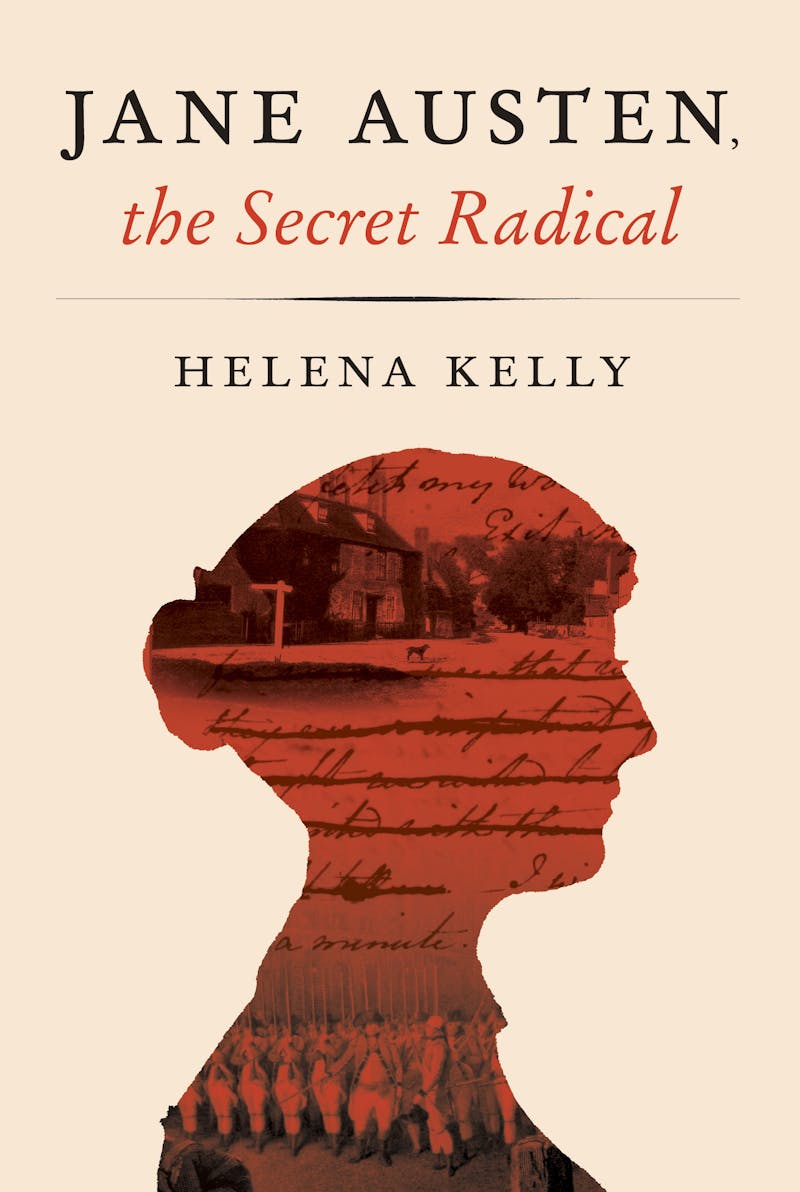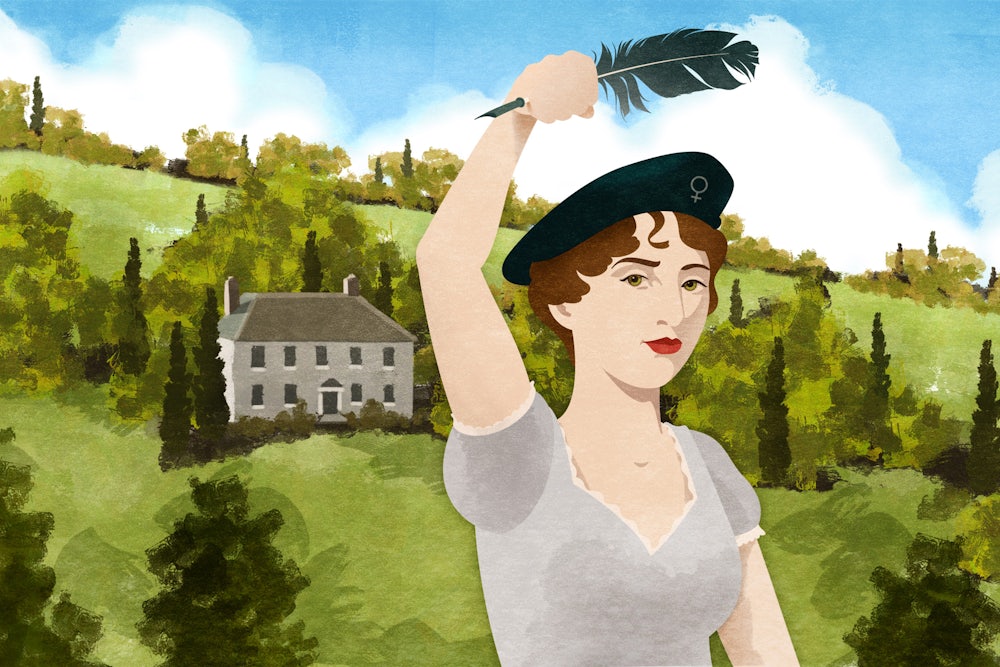Many years ago, I went to a conference of the Jane Austen Society of North America. We met in the Fairmont Chateau at Lake Louise in the Canadian Rockies, which was said to be the original of the hotel in Stephen King’s The Shining. But this time it was the setting for a different kind of eerie displacement: nearly 600 Austen enthusiasts, many wearing Regency costumes, decked out in ribbons and bonnets, and carrying reticules, fans, and parasols.
While Janeites love partying and cosplay, they are interested in much more than cream teas. Most have an expert knowledge of Austen’s six novels, as well as two centuries of scholarship, and their conferences include panels and talks by learned Austen scholars, alongside the balls and excursions. This year is an especially big one for Austen devotees. The bicentennial of her death brings the release of annotated anniversary editions of her novels and critical studies such as The Making of Jane Austen by Devoney Looser and Reading Austen in America by Juliette Wells. There will be dozens of exhibitions and commemorations from America to Australia. The Bank of England will even issue a ten-pound note with Austen’s picture on it.

Jane Austen, the Secret Radical, a new book by Oxford lecturer Helena Kelly, shares the Janeites’ obsessiveness, but not their fondness for the novels’ genteel settings and closely observed manners. Insisting that Austen’s work has always been misread as “an undifferentiated procession of witty, ironical stories about romance and drawing rooms,” Kelly promises to reveal a hitherto unknown and unrecognized Jane Austen. This “radical” Austen meticulously constructed her books to show a “complicated, messy” world, “filled with error and injustice.”
To uncover this subversive text, Kelly argues, “we have to read carefully.” Austen couldn’t be “too explicit, too obvious” in her writing, because she lived in a society “that was, essentially, totalitarian.” Instead, Austen planted clues and codes, trusting her readers “to mine her books for meaning, just as readers in Communist states learned how to read what writers had to learn how to write.” In Kelly’s view, Austen’s novels are a kind of samizdat, concealing radical messages beneath their conventional surfaces.
Kelly never says, however, what she means by “radical.” Is Austen’s radicalism a political agenda, a feminist critique, a theological question, or just feminine self-assertion? Kelly provides very few clues. At one point, she describes Elizabeth Bennett in Pride and Prejudice as “a radical” because she “knows her own mind” and “reserves the right to decide questions for herself.” Does accepting the idea that Austen was a secret radical, who wrote, according to one reviewer, “about the burning political issues of the time,” make reading the novels any more pleasurable or interesting? Or is it necessary for us to redefine Austen as politically engaged and indignant in order to respect her as a serious woman writer?
Kelly is far from the first critic to engage with political issues in Austen’s fiction. In her 1987 study Jane Austen and the State, Mary Evans called Mansfield Park a “radical critique of bourgeois patriarchy.” For at least 30 years the novel has been at the center of a controversy about how much Austen knew about slavery and what she thought about it, as the heroine’s uncle, Sir Thomas Bertram, owns not just Mansfield Park but also a sugar plantation in Antigua. In Culture and Imperialism, Edward Said accused Austen of indifference to the slave trade and, because of her silence about it, complicity. Said’s interpretation inspired the 1999 film of Mansfield Park, in which Harold Pinter plays Bertram as a bullying, belligerent, slave-owning patriarch.
Yet Kelly does not credit or address these scholars and their critiques. Her case for the radicalism of the novels rests instead on a mixture of psychological interpretation and political hypothesis—sometimes ingenious, but more often speculative and circular. She loves solving “word games and anagrams” that she alone has detected in Austen’s fiction, all of which somehow turn out to support her argument. She finds a political theme in each of the novels, and they all make the comedy darker and the happy endings questionable. Northanger Abbey is about the “terrifying risk” of marriage and childbirth for women. Sense and Sensibility is a world in which “love and family, honor and duty, have hardly any meaning.”
When we get to Austen’s most sunny and beloved novel, Pride and Prejudice, Kelly admits that a radical reading is more difficult. Still, she maintains, “any reader fully sensitized to the loaded language of revolution and counterrevolution would have read Pride and Prejudice for what it is—a revolutionary fairy tale.” In Austen’s many references to soldiers, Kelly sees “images of a rebellious populace, of government repression, and, more distant but insistent nevertheless … of mutiny.” Austen’s novels show English society is as snobbish, class-determined, cruel, and unequal as pre-revolutionary France, but rebellion against a repressive class system, Kelly concludes, is symbolically prevented in the plot by the “radical marriage” across class differences of Elizabeth (moderately wealthy gentry) and Darcy (very wealthy gentry).
Unlike Said, Kelly views Mansfield Park as commenting intentionally on the hidden evil of slavery in Britain. The book’s title, Kelly argues, recalls the name of William Murray, Lord Mansfield, a judge who ruled in 1772 that English law did not permit the ownership of slaves. “It would have been unforgivably careless of Jane,” Kelly writes, “to attach Mansfield’s name, out of all the names she could have chosen, to this novel unless she meant her readers to think about him and about slavery.” She proposes that Austen left a series of such clues linking the “unforgivable sin” of slavery to the Church of England, which gave it “a veneer of Christian respectability.” Yet the evidence is hardly persuasive: Since the novel was not reviewed when it was published, we have no idea whether a contemporary reader thought of Lord Mansfield in connection with it, or noticed any critique of slavery in Austen’s satire of the clergy.
Kelly finds a much more elaborate political scenario in Emma, which she reads as a coded attack on enclosure of common land by the gentry. Recalling a scene in which gypsies are camped by a roadside, she views Emma as a novel about the hardship, desperation, and need of the poor, whose access to the common land has been stolen. Mr. Knightley, far from being a perfect partner for the heroine, Kelly contends, is an exploitative, hard-hearted lord of the manor with pedophilic inclinations. (In a “shocking moment,” he confesses to Emma that he has been in love with her since she was 13.) Likewise, Kelly insists that the allegedly happy reconciliation of two long-estranged aging lovers in Persuasion is a romantic illusion. The real message of the book, less Shakespearean comedy than existential despair, is that history is “random, chaotic, filled with death and destruction.” So much for the delights of the Jane Austen book club.
Kelly presents herself as an authoritative guide not only to Austen’s secret political meanings, but also to her intentions. In novelistic introductions to each chapter, she recreates several periods in Austen’s life, even channeling her deathbed musings. “She has done them justice, to the best of her poor ability, her books, her children,” Kelly imagines Austen thinking. “What will become of them all, after she’s gone?”
Kelly’s claim to have read each of the six novels “as Jane intended us to” is a bold one, but it’s undermined by her own writing and perspective. She describes Austen as “an authoress,” an antiquated feminine form that, like “poetess,” serves to trivialize Austen as a woman writer. And throughout the book she refers to her subject as “Jane”—a strange usage in a work that seeks to present Austen as a great artist. No critic, after all, writes about Charles’s critiques of injustice, Henry’s complex style, or Joseph’s revolutionary ideas.
Some Austen experts, while critical of Kelly’s methods, have been amusedly tolerant of what John Mullan calls her “divertingly unlikely” discoveries. Indeed, Kelly is an ingenious and entertaining critic, and an engaging writer. She asks a lot of rhetorical questions and disarmingly admits to uncertainty. What did Jane Austen write between 1803 and the spring of 1809? “Maybe she was working on preexisting drafts or on pieces that were later incorporated into the other novels. Maybe she was writing something she later destroyed. We simply don’t know.” Kelly also points out the sexual subtexts of Austen’s decorous prose, from the “thinly veiled description of female masturbation” in Northanger Abbey to the “close, rough, forcible” hug that Fanny Price’s father imposes on her, “a pressing together of bodies” implicitly illicit and intimate.
Writing in The Times Literary Supplement, Devoney Looser compares Kelly to Virginia Woolf, who also speculated wildly about Jane Austen: “Both are skilled, provocative literary critics who make lousy, error-ridden literary historians.” The comparison to Woolf is a big stretch. Woolf grasped the fundamental concerns of the novels—unsentimental acceptance of the economic realities that forced women into marriage; respect for the natural aristocracy of intelligence, humor, and kindness; social satire; and the subtle morality of human relationships—whereas Kelly’s book leads us away from them. Austen’s novels have survived for 200 years on her art, her characters, her wit, and her profound portrayal of women’s lives. That should be sufficiently radical to sustain her reputation a while longer.
